instrument cluster MAZDA MODEL CX-3 2016 Smart Start Guide (in English)
[x] Cancel search | Manufacturer: MAZDA, Model Year: 2016, Model line: MODEL CX-3, Model: MAZDA MODEL CX-3 2016Pages: 46, PDF Size: 5.18 MB
Page 3 of 46
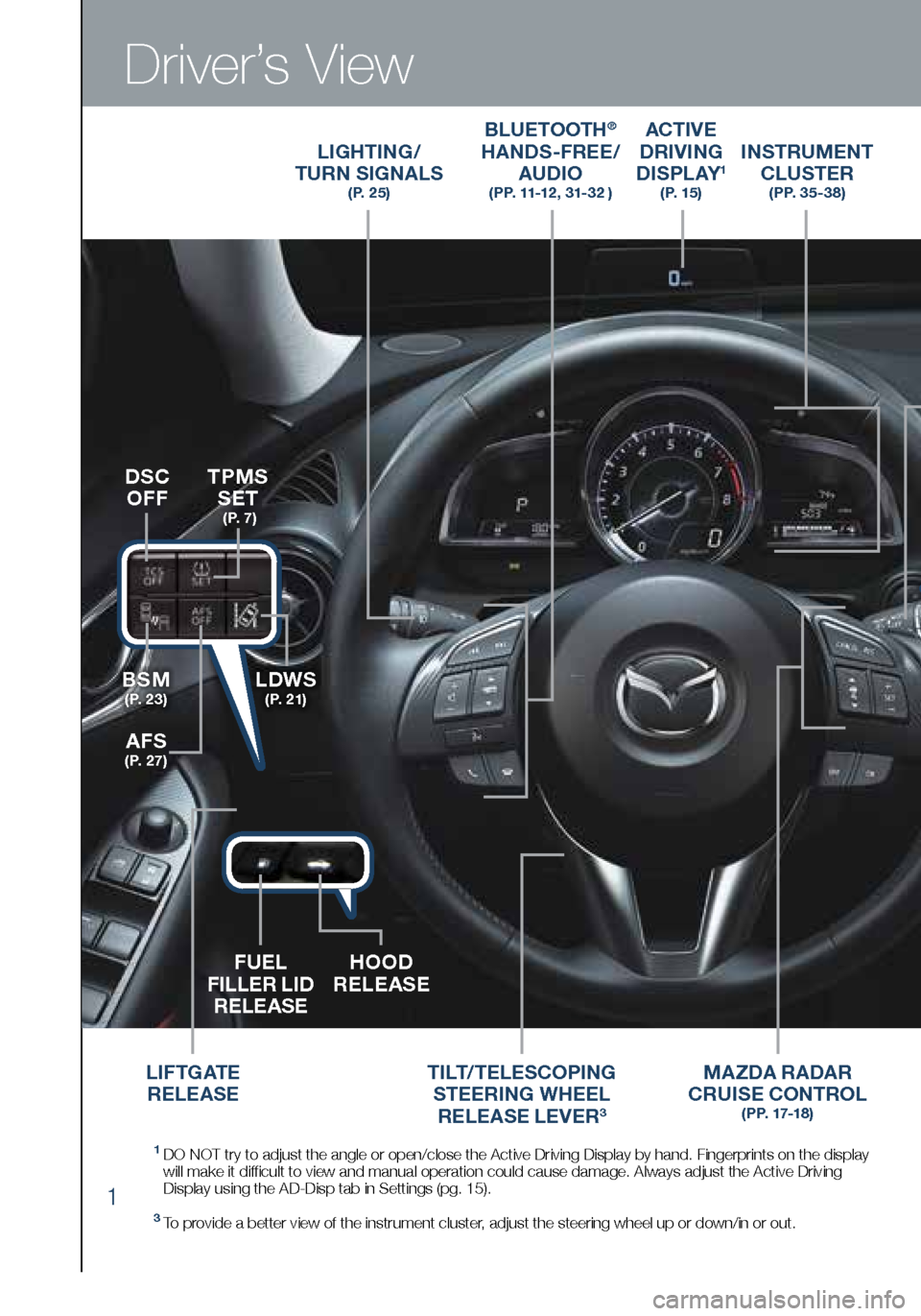
1
Driver’s View
LIGHTING/
TURN SIGNALS
( P. 2 5 )
BLUETOOTH®
HANDS-FREE/
AUDIO
(PP. 11-12 , 31-32 )
ACTIVE
DRIVING
D I S P L AY
1 ( P. 1 5 )
TILT/TELESCOPING
STEERING WHEEL
RELEASE LEVER
3
AFS
( P. 2 7 )
MA ZDA RADAR
CRUISE CONTROL
( P P. 17-1 8 )
FUEL
FILLER LID RELEASE HOOD
RELEASE
INSTRUMENT
CLUSTER
( P P. 3 5 - 3 8 )
1 DO NOT try to adjust the angle or open/close the Active Driving Display \
by hand. Fingerprints on the display
will make it difficult to view and manual operation could cause damage. Always adjust \
the Active Driving
Display using the AD-Disp tab in Settings (pg. 15).
3 To provide a better view of the instrument cluster, adjust the steering wheel up or down/in or out.
L I F T G AT E
RELEASE
BSM
( P. 2 3 )LDWS
( P. 2 1 )
TPMS SET
( P. 7 )DSC
OFF
1880737_16a_Mazda_CX-3_061615.indd 16/16/15 2:26 PM
Page 7 of 46
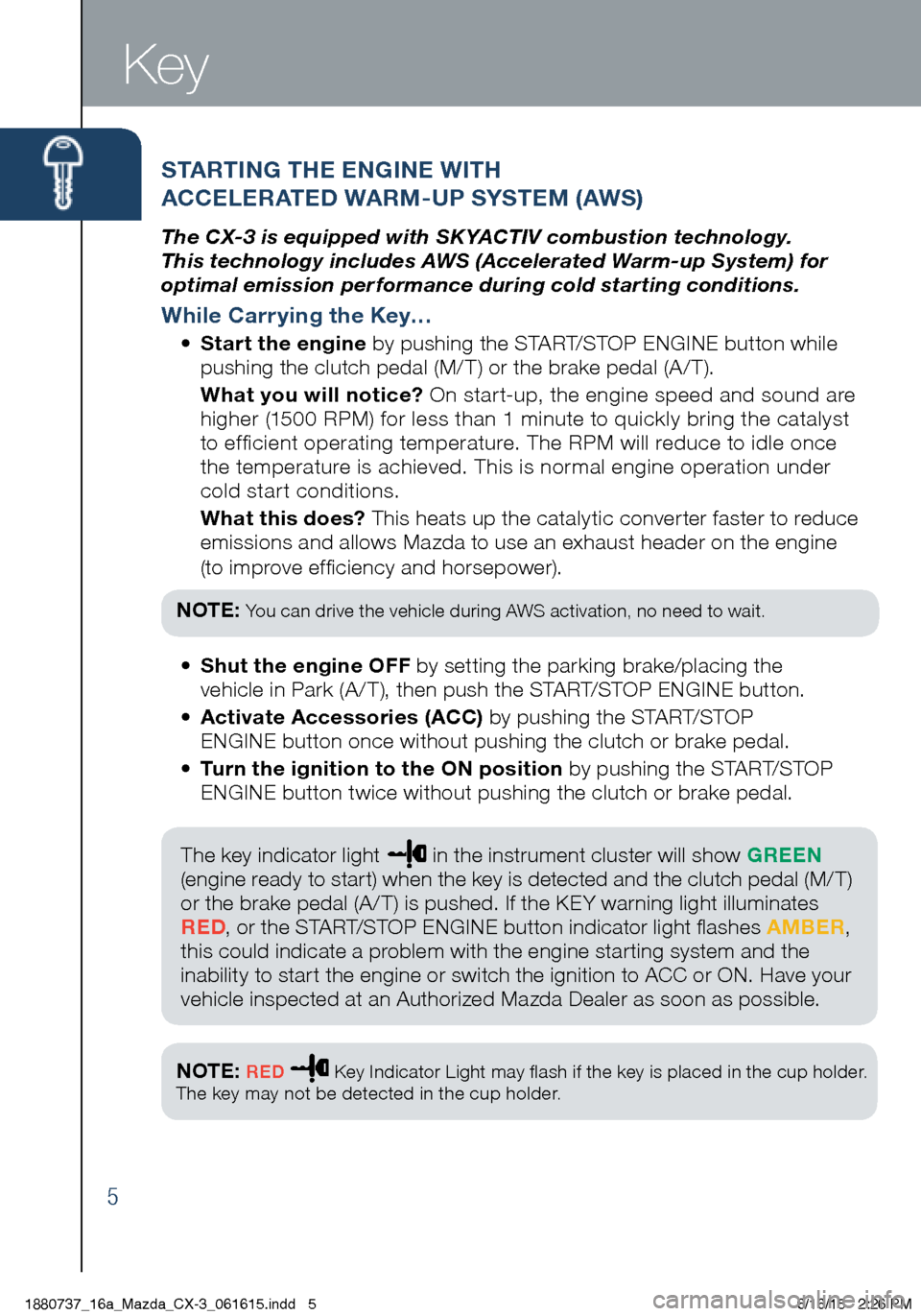
5
STARTING THE ENGINE WITH
ACCELERATED WARM-UP SYSTEM (AWS)
The CX-3 is equipped with SKYACTIV combustion technology.
This technology includes AWS (Accelerated Warm-up System) for
optimal emission performance during cold starting conditions.
While Carrying the Key…
• Start the engine by pushing the START/STOP ENGINE button while
pushing the clutch pedal (M/ T) or the brake pedal (A / T).
What you will notice? On start-up, the engine speed and sound are
higher (1500 RPM) for less than 1 minute to quickly bring the catalyst
to efficient operating temperature. The RPM will reduce to idle once
the temperature is achieved. This is normal engine operation under
cold start conditions.
What this does? This heats up the catalytic converter faster to reduce
emissions and allows Mazda to use an exhaust header on the engine
(to improve efficiency and horsepower).
NOTE:
Yo u can drive the vehicle during AWS activation, no need to wait.
Key
• Shut the engine OFF by setting the parking brake/placing the
vehicle in Park (A / T), then push the START/STOP ENGINE button.
• Activate Accessories (ACC) by pushing the START/STOP
ENGINE button once without pushing the clutch or brake pedal.
• Turn the ignition to the ON position by pushing the START/STOP
ENGINE button twice without pushing the clutch or brake pedal.
The key indicator light
in the instrument cluster will show GREEN
(engine ready to start) when the key is detected and the clutch pedal (M/ T)
or the brake pedal (A / T) is pushed. If the KEY warning light illuminates
RED , or the START/STOP ENGINE button indicator light flashes AMBER ,
this could indicate a problem with the engine starting system and the
inability to start the engine or switch the ignition to ACC or ON. Have your
vehicle inspected at an Authorized Mazda Dealer as soon as possible.
NOTE:
RED Key Indicator Light may flash if the key is placed in the cup holder.
The key may not be detected in the cup holder .
1880737_16a_Mazda_CX-3_061615.indd 56/16/15 2:26 PM
Page 9 of 46
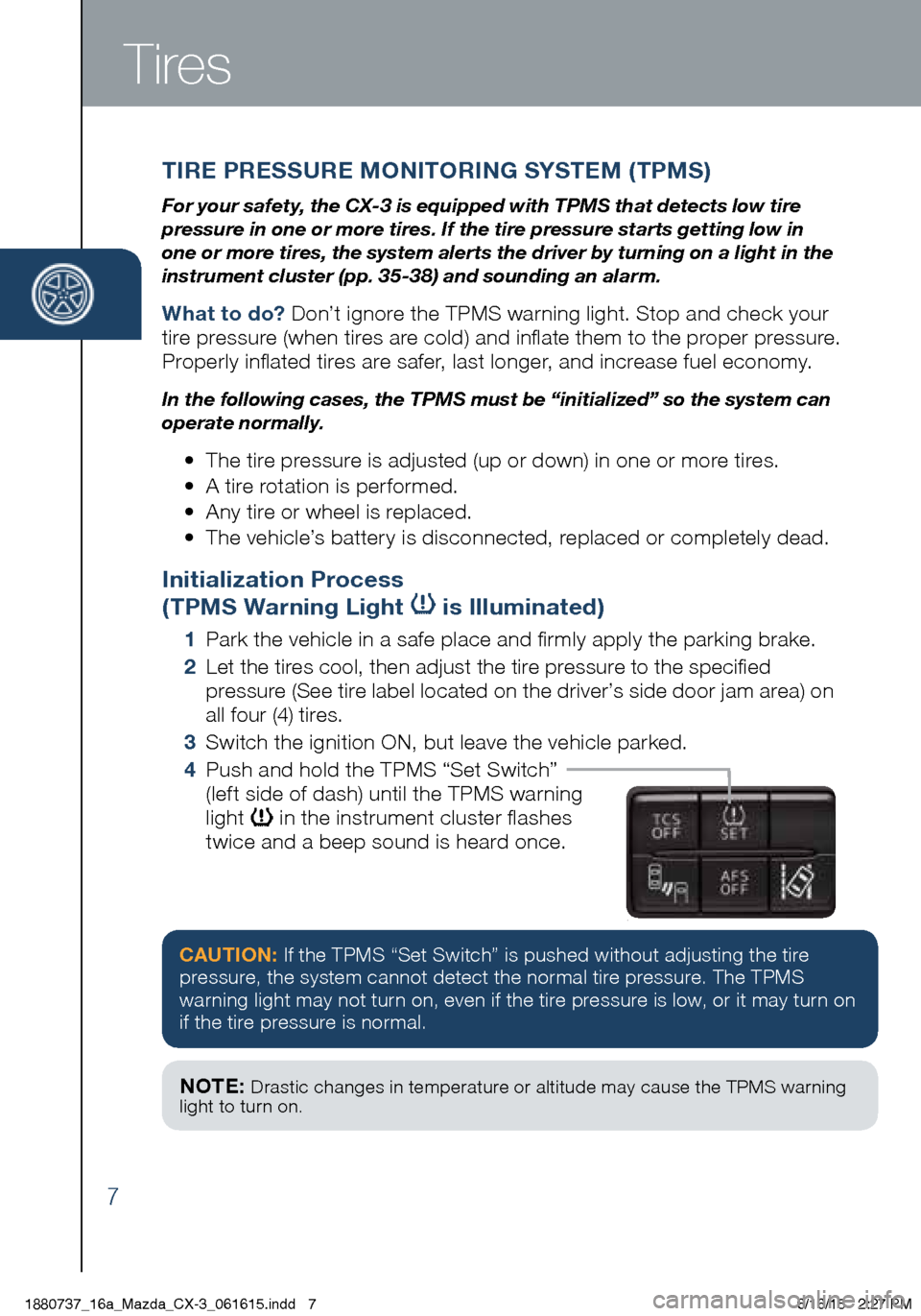
7
Tires
TIRE PRESSURE MONITORING SYSTEM (TPMS)
For your safety, the CX-3 is equipped with TPMS that detects low tire
pressure in one or more tires. If the tire pressure starts getting low in
one or more tires, the system alerts the driver by turning on a light in the
instrument cluster (pp. 35-38) and sounding an alarm.
What to do? Don’t ignore the TPMS warning light. Stop and check your
tire pressure (when tires are cold) and inflate them to the proper pressure.
Properly inflated tires are safer, last longer, and increase fuel economy.
In the following cases, the TPMS must be “initialized” so the system can
operate normally.
• The tire pressure is adjusted (up or down) in one or more tires.
• A tire rotation is performed.
• Any tire or wheel is replaced.
• The vehicle’s battery is disconnected, replaced or completely dead.
Initialization Process
(TPMS Warning Light
is Illuminated)
1 Park the vehicle in a safe place and firmly apply the parking brake.
2 Let the tires cool, then adjust the tire pressure to the specified
pressure (See tire label located on the driver’s side door jam area) on
all four (4) tires.
3 Switch the ignition ON, but leave the vehicle parked.
4 Push and hold the TPMS “Set Switch”
(left side of dash) until the TPMS warning
light
in the instrument cluster flashes
twice and a beep sound is heard once.
CAUTION: If the TPMS “Set Switch” is pushed without adjusting the tire
pressure, the system cannot detect the normal tire pressure. The TPMS
warning light may not turn on, even if the tire pressure is low, or it may turn on
if the tire pressure is normal.
NOTE: Drastic changes in temperature or altitude may cause the TPMS warning
light to turn on.
1880737_16a_Mazda_CX-3_061615.indd 76/16/15 2:27 PM
Page 17 of 46

15
The Active Driving Display displays the following information:• Vehicle Speed Setting
using cruise control
• Navigation Turn-by-Turn
(TBT) direction, distance
and lane guidance
•
Lane Departure Warning
System (LDWS) operation
conditions and warnings
• Smart City Brake
Support (SCBS)
warnings
• Vehicle Speed Setting
using cruise control
(if equipped)
To change the settings/adjustments for the Active Driving Display:
1 Select the Settings icon on the
Home screen.
2 Select the AD-Disp tab.
3 Select the desired item to change.
• Height: Adjust the position of the
virtual image of the Active Driving
Display up or down.
• Brightness Control: Method
for adjusting screen brightness
(Automatically with instrument
cluster illumination or manually). •
Calibration: Brightness
initialization setting (when
selecting automatic adjustment).
• Brightness: Brightness
adjustment (when selecting
manual adjustment).
• Navigation: On/O f f.
• Active Driving Display:
On/O f f.
• Reset: Reset to
default settings.
50 mph
0 MPH
Active Driving Display
NOTE:• If the display does not operate, switch the ignition off and then switch it back on. If it
still does not operate even with the ignition switched ON, have the vehicle inspected at
an Authorized Mazda Dealer.
• It may be difficult to view the display when wearing sunglasses. Take off your
sunglasses or adjust the luminosity.
• If the batter y has been removed and re-installed or the batter y voltage is low, the
adjusted position may deviate.
• The display may be difficult to view or temporarily affected by weather conditions such
as rain, snow, light, and temperature.
ACTIVE DRIVING DISPLAY (if equipped)
CAUTION: Always adjust the display
using the Settings screen (AD-Disp
tab). Do not try to adjust the angle
or open/close the display by hand.
Fingerprints on the display will
make it difficult to view and manual
operation could cause damage.
1880737_16a_Mazda_CX-3_061615.indd 156/16/15 2:27 PM
Page 19 of 46
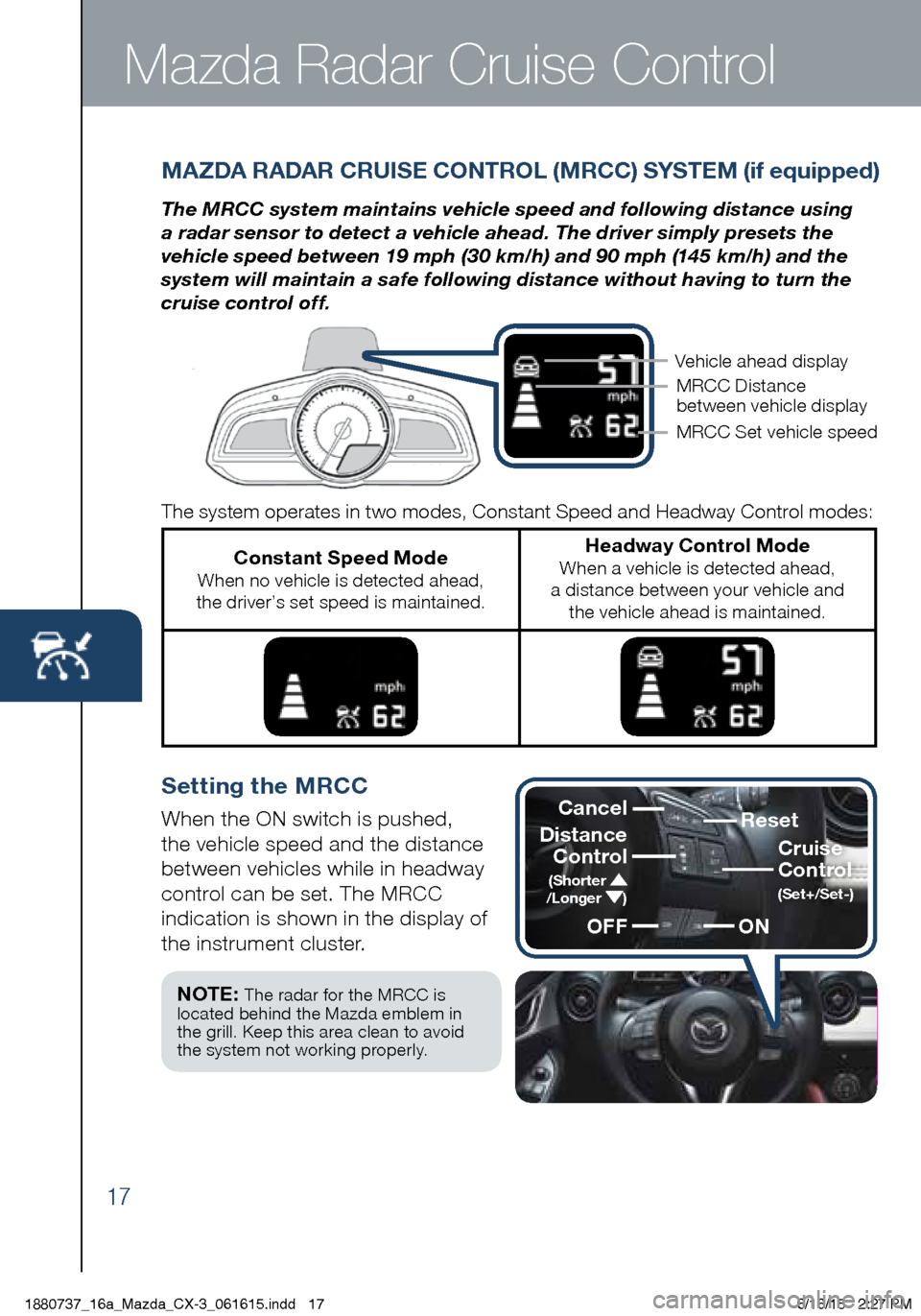
17
Mazda Radar Cruise Control
MAZDA RADAR CRUISE CONTROL (MRCC) SYSTEM (if equipped)
The MRCC system maintains vehicle speed and following distance using
a radar sensor to detect a vehicle ahead. The driver simply presets the
vehicle speed between 19 mph (30 km/h) and 90 mph (145 km/h) and the
system will maintain a safe following distance without having to turn the
cruise control off.
Setting the MRCC
When the ON switch is pushed,
the vehicle speed and the distance
between vehicles while in headway
control can be set. The MRCC
indication is shown in the display of
the instrument cluster.
The system operates in two modes, Constant Speed and Headway Control modes:
Constant Speed Mode When no vehicle is detected ahead,
the driver’s set speed is maintained.
Headway Control Mode When a vehicle is detected ahead,
a distance between your vehicle and the vehicle ahead is maintained.
NOTE: The radar for the MRCC is
located behind the Mazda emblem in
the grill. Keep this area clean to avoid
the system not working properly.
Vehicle ahead display
MRCC Distance
between vehicle display
MRCC Set vehicle speed
Reset
ON
Cruise
Control
(Set+/Set-)
Cancel
Distance Control
(Shorter /Longer )
OFF
1880737_16a_Mazda_CX-3_061615.indd 176/16/15 2:27 PM
Page 20 of 46
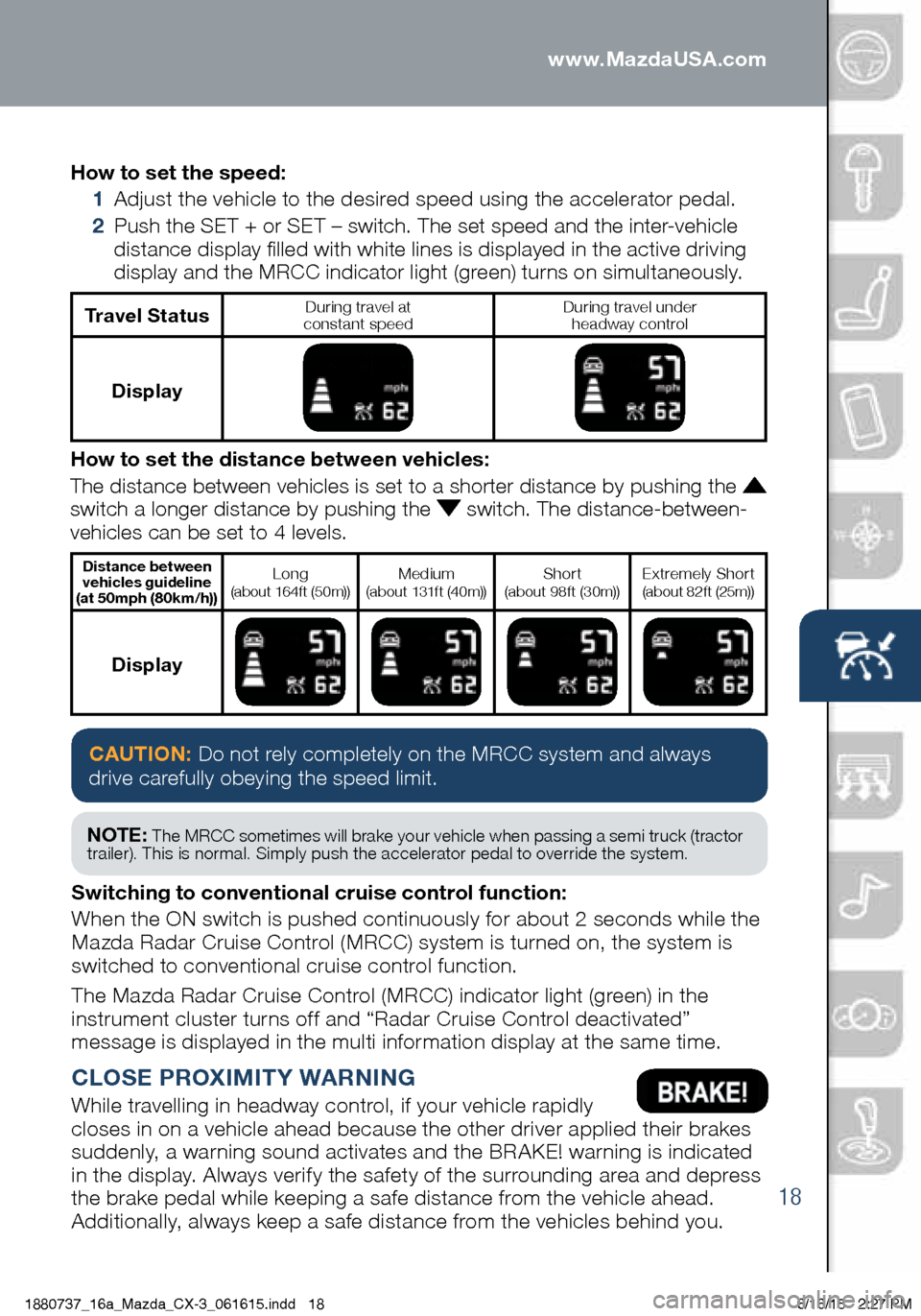
18
How to set the speed:
1 Adjust the vehicle to the desired speed using the accelerator pedal.
2 Push the SET + or SET – switch. The set speed and the inter-vehicle
distance display filled with white lines is displayed in the active driving
display and the MRCC indicator light (green) turns on simultaneously.
Travel StatusDuring travel at
constant speed During travel under
headway control
Display
How to set the distance between vehicles:
The distance between vehicles is set to a shorter distance by pushing th\
e
switch a longer distance by pushing the switch. The distance-between-
vehicles can be set to 4 levels.
Distance between vehicles guideline
(at 50mph (80km/h))Long (about 164f t (50m))Medium
(about 131f t (40m))Shor t (about 98f t (30m))Extremely Shor t (about 82f t (25m))
Display
CAUTION: Do not rely completely on the MRCC system and always
drive carefully obeying the speed limit.
NOTE: The MRCC sometimes will brake your vehicle when passing a semi truck (tractor
trailer). This is normal. Simply push the accelerator pedal to override the system.
CLOSE PROXIMITY WARNING
While travelling in headway control, if your vehicle rapidly
closes in on a vehicle ahead because the other driver applied their brakes
suddenly, a warning sound activates and the BRAKE! warning is indicated
in the display. Always verify the safety of the surrounding area and depress
the brake pedal while keeping a safe distance from the vehicle ahead.
Additionally, always keep a safe distance from the vehicles behind you. Switching to conventional cruise control function:
When the ON switch is pushed continuously for about 2 seconds while the
Mazda Radar Cruise Control (MRCC) system is turned on, the system is
switched to conventional cruise control function.
The Mazda Radar Cruise Control (MRCC) indicator light (green) in the
instrument cluster turns off and “Radar Cruise Control deactivated”
message is displayed in the multi information display at the same time.
1880737_16a_Mazda_CX-3_061615.indd 186/16/15 2:27 PM
www.MazdaUSA.com
Page 22 of 46

20
Smart Brake Support
SMART BRAKE SUPPORT (SBS) (if equipped)
The Smart Brake Support (SBS) is a system which alerts the driver
of a possible collision using an indicator and warning sound in the
instrument cluster while the vehicle is being driven at about 10 mph
(15 km/h) or faster and the system’s radar sensor determines that
your vehicle may hit a vehicle ahead. Furthermore, if the radar sensor
determines that a collision is unavoidable, the automatic brake control
is performed to reduce damage in the event of a collision. In addition,
when the driver depresses the brake pedal, the brakes operate more
quickly to assist the driver.
Refer to your Owner’s Manual for complete details.
Radar sensorLaser sensor
Collision Warning
If there is the possibility of a collision with a vehicle ahead,
the beep sounds continuously and a warning is indicated in
the multi-information display. SBS system can be turned off using Safety Settings in MAZDA CONNECT.
(see page 16)
WARNING: SBS is only a supplementary system to reduce damage in the
event of a collision, however the SBS has limitations. Do not rely solely on the
SBS, Always keep your eyes on the road.
1880737_16a_Mazda_CX-3_061615.indd 206/16/15 2:27 PM
www.MazdaUSA.com
Page 25 of 46
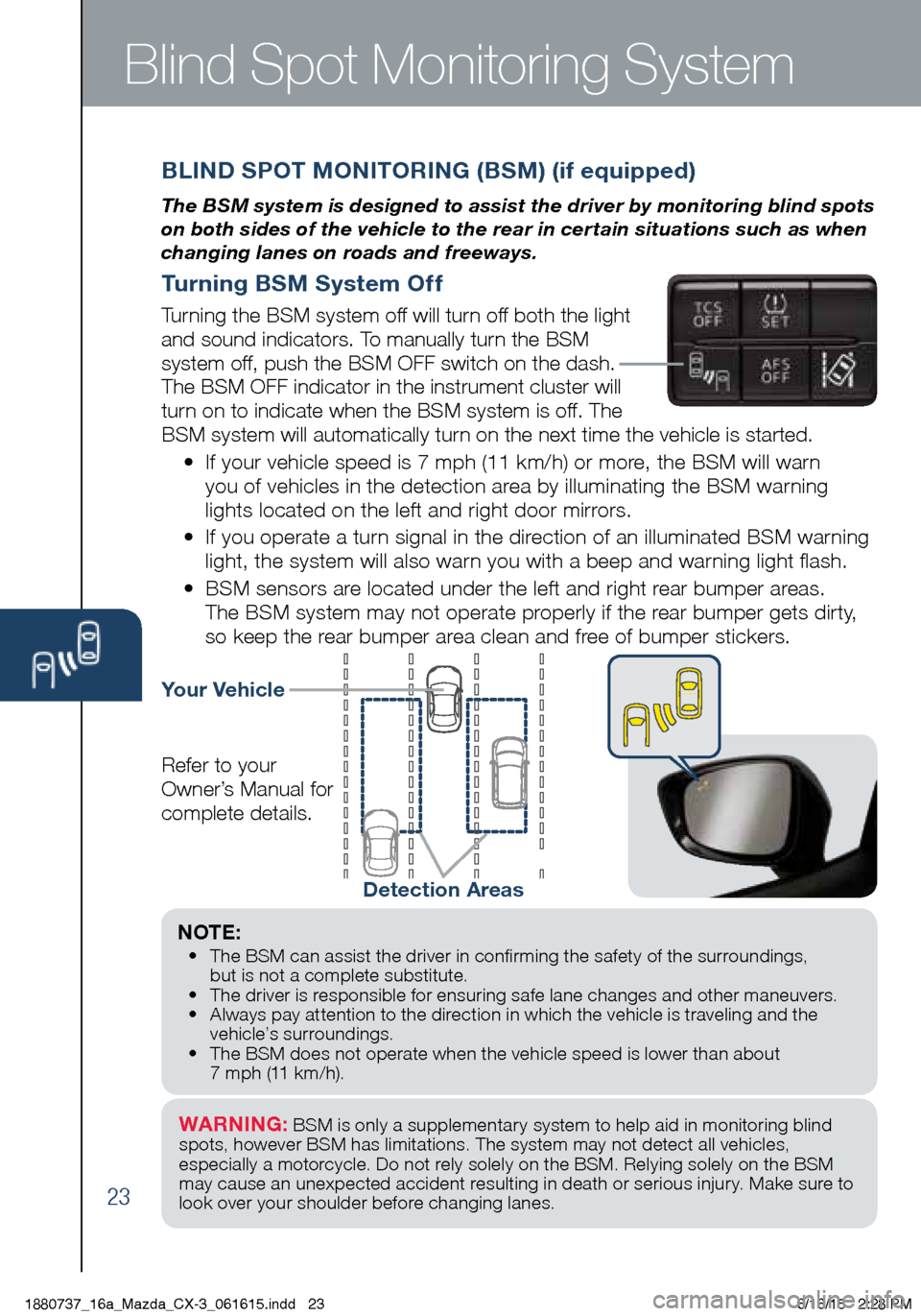
23
Blind Spot Monitoring System
BLIND SPOT MONITORING (BSM) (if equipped)
The BSM system is designed to assist the driver by monitoring blind spots
on both sides of the vehicle to the rear in certain situations such as when
changing lanes on roads and freeways.
Turning BSM System Off
Turning the BSM system off will turn off both the light
and sound indicators. To manually turn the BSM
system off, push the BSM OFF switch on the dash.
The BSM OFF indicator in the instrument cluster will
turn on to indicate when the BSM system is off. The
BSM system will automatically turn on the next time the vehicle is started.
• If your vehicle speed is 7 mph (11 km/h) or more, the BSM will warn
you of vehicles in the detection area by illuminating the BSM warning
lights located on the left and right door mirrors.
• If you operate a turn signal in the direction of an illuminated BSM warning
light, the system will also warn you with a beep and warning light flash.
• BSM sensors are located under the left and right rear bumper areas.
The BSM system may not operate properly if the rear bumper gets dirty,
so keep the rear bumper area clean and free of bumper stickers.
Your Vehicle
Detection Areas
Refer to your
Owner’s Manual for
complete details.
NOTE: • The BSM can assist the driver in confirming the safety of the surroundings,
but is not a complete substitute.
• The driver is responsible for ensuring safe lane changes and other maneuvers.
• Always pay attention to the direction in which the vehicle is traveling and the
vehicle’s surroundings.
• The BSM does not operate when the vehicle speed is lower than about
7 mph (11 km/h).
WARNING: BSM is only a supplementary system to help aid in monitoring blind
spots , however BSM has limitations. The system may not detect all vehicles,
especially a motorcycle. Do not rely solely on the BSM . Relying solely on the BSM
may cause an unexpected accident resulting in death or serious injury. Make sure to
look over your shoulder before changing lanes.
1880737_16a_Mazda_CX-3_061615.indd 236/16/15 2:28 PM
Page 30 of 46
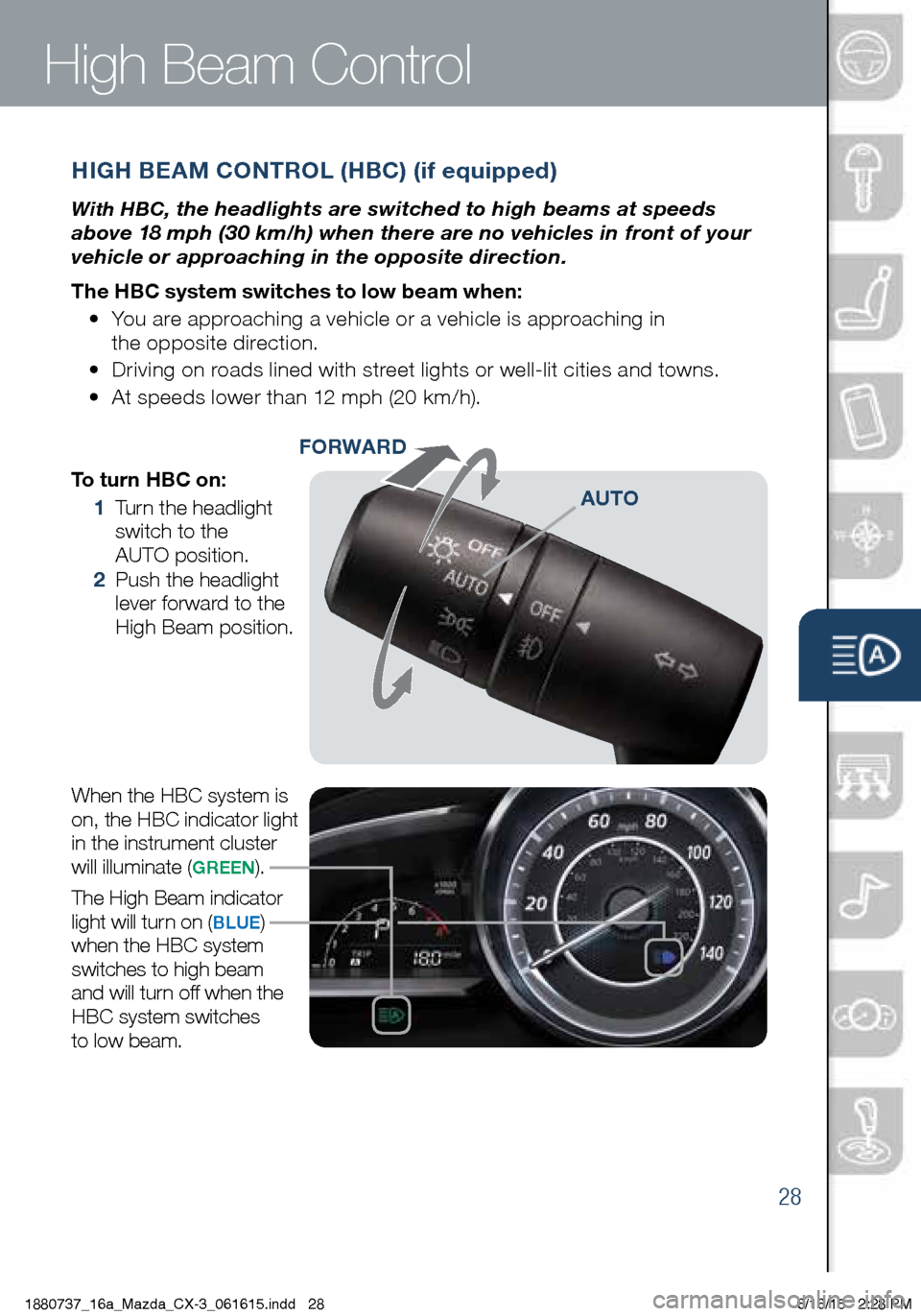
28
To turn HBC on:
1 Turn the headlight
switch to the
AUTO position.
2 Push the headlight
lever forward to the
High Beam position.
When the HBC system is
on, the HBC indicator light
in the instrument cluster
will illuminate (
GREEN).
The High Beam indicator
light will turn on (
BLUE)
when the HBC system
switches to high beam
and will turn off when the
HBC system switches
to low beam.
HIGH BEAM CONTROL (HBC) (if equipped)
With HBC, the headlights are switched to high beams at speeds
above 18 mph (30 km/h) when there are no vehicles in front of your
vehicle or approaching in the opposite direction.
The HBC system switches to low beam when:
• You are approaching a vehicle or a vehicle is approaching in
the opposite direction.
• Driving on roads lined with street lights or well-lit cities and towns.
• At speeds lower than 12 mph (20 km/h).
AUTO
FORWARD
High Beam Control
1880737_16a_Mazda_CX-3_061615.indd 286/16/15 2:28 PM
www.MazdaUSA.com
Page 37 of 46
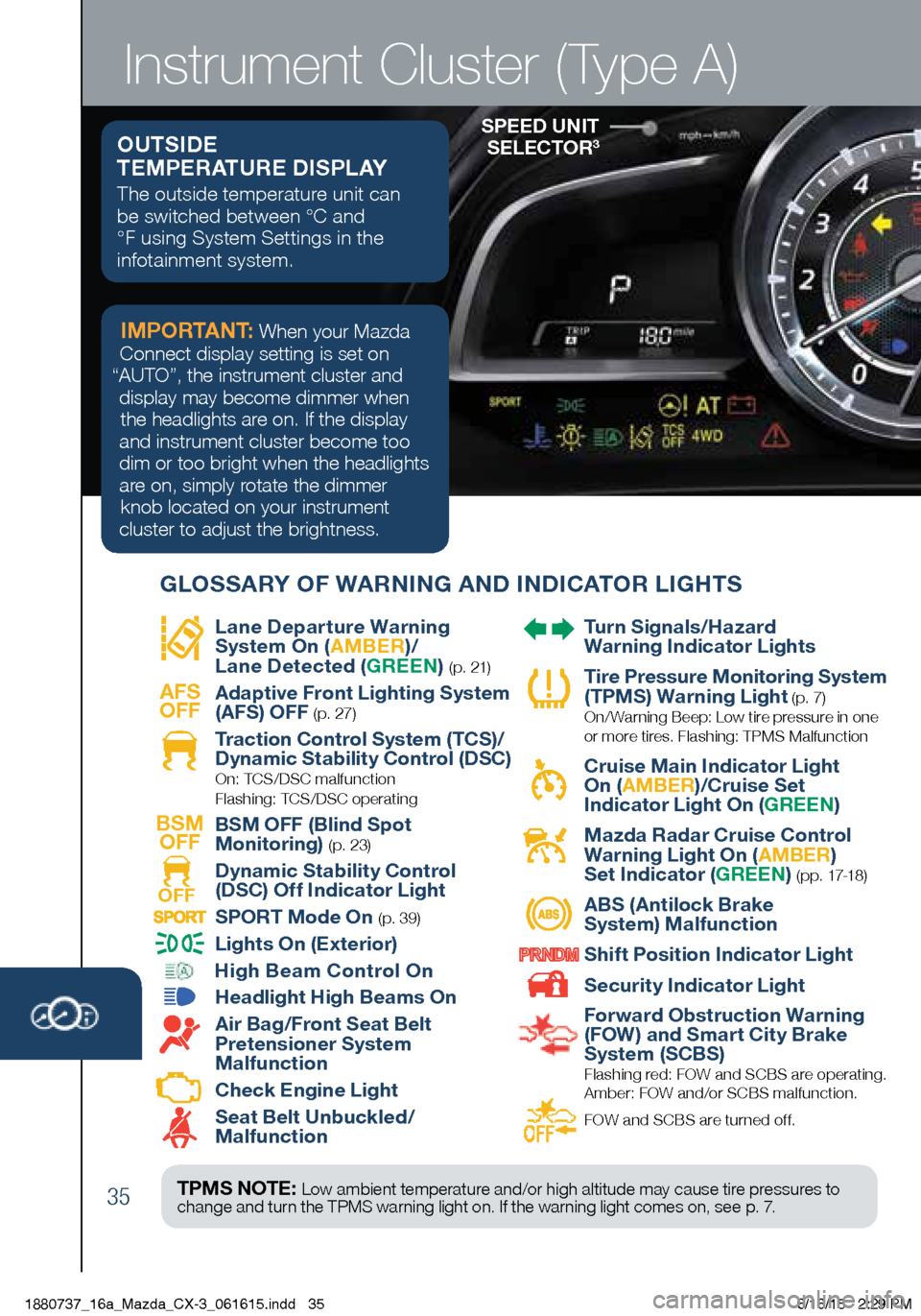
35
Instrument Cluster (Type A)
SPEED UNIT SELECTOR3
Lane Departure Warning
System On (
AMBER)/
Lane Detected ( GREEN) ( p. 21)
AFS
OFF
Adaptive Front Lighting System
(AFS) OFF (p. 27)
Traction Control System (TCS)/
Dynamic Stability Control (DSC)
On: TCS/DSC malfunction
Flashing: TCS/DSC operating
BSM OFF
BSM OFF (Blind Spot
Monitoring)
(p. 23)
OFF Dynamic Stability Control
(DSC) Off Indicator Light SPORT Mode On (p. 39)
Lights On (Exterior)
High Beam Control On
Headlight High Beams On
Air Bag/Front Seat Belt
Pretensioner System
Malfunction
Check Engine Light
Seat Belt Unbuckled/
Malfunction
Turn Signals/Hazard
Warning Indicator Lights
Tire Pressure Monitoring System
(TPMS) Warning Light (p. 7) On/ Warning Beep: Low tire pressure in one
or more tires. Flashing: TPMS Malfunction
Cruise Main Indicator Light
On ( AMBER )/Cruise Set
Indicator Light On ( GREEN)
Mazda Radar Cruise Control
Warning Light On ( AMBER)
Set Indicator ( GREEN)
( p p . 17-18 )
ABS (Antilock Brake
System) Malfunction
Shift Position Indicator Light
Security Indicator Light
Forward Obstruction Warning
(FOW ) and Smart City Brake
System (SCBS)
Flashing red: FOW and SCBS are operating.
Amber: FOW and/or SCBS malfunction.
FOW and SCBS are turned of f.
TPMS NOTE:
Low ambient temperature and/or high altitude may cause tire pressures to
change and turn the TPMS warning light on. If the warning light comes on, see p. 7.
OUTSIDE
TEMPERATURE DISPLAY
The outside temperature unit can
be switched between °C and
°F using System Settings in the
infotainment system.
IMPORTANT: When your Mazda
Connect display setting is set on
“AUTO”, the instrument cluster and display may become dimmer when the headlights are on. If the display
and instrument cluster become too
dim or too bright when the headlights are on, simply rotate the dimmer knob located on your instrument
cluster to adjust the brightness.
GLOSSARY OF WARNING AND INDICATOR LIGHTS
1880737_16a_Mazda_CX-3_061615.indd 356/16/15 2:29 PM